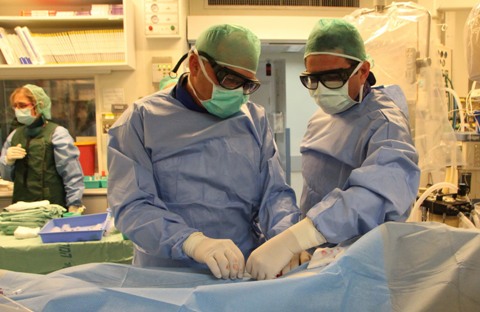This week Hillel Yaffe Medical Center joined the ranks of medical centers that offer treatment with a left atrial appendage closure device using a catheter-based technique. "This technology is implemented by the Cardiology Institute staff and is a solution for patients with atrial fibrillation, but cannot take anticoagulants," said Dr. Mark Kazatsker, Head of Electrophysiology, Pacemaker & Arrhythmias Service at HYMC. "This is a procedure that was added to the drug basket, and it is performed through catheterization. It reduces the risk of strokes due blood clots, and makes it unnecessary to take anticoagulants such as Coumadin."
What is atrial fibrillation?
Atrial fibrillation is the most common cardiac arrhythmia and affects 1-2% of the entire population. The prevalence doubles each decade, reaching 9% in the age group of 80-90. Atrial fibrillation increases the risk of blood clots in the atria due to ineffective atrial contraction and poorer blood circulation.
Anticoagulants are a standard treatment that dramatically reduces morbidity and mortality rates. However, there is a relatively large group of patients who, for various reasons, cannot use anticoagulants due to recurrent falls with wounds, brain hemorrhage or life-threatening bleeding in the digestive tract, noncompliance and more. "For these patients," stated Dr. Kazatsker, "The insertion of the device can have a meaningful difference in quality of life."
What is the advantage of inserting the device?
The technique used for left atrial appendage closure is performed with a catheter, under general anesthetic and using trans-esophageal electrocardiogram technology. It requires all Cardiology Institute staff, from all fields to work together - Catheterization Unit, Non-Invasive Cardiology Unit and Pacemaker Service. During the procedure a unique catheter is inserted into the femoral vein and is guided by the physician to the right atrium, crossing the inter-atrial septum and reaching the left atrium, where the device is placed. After reaching the right position, the device on the catheter opens in a mushroom shape that blocks the entry of blood into the appendage, thus preventing it from pooling and clotting. This reduces the patients' risk of developing blood clots and their entry into the system as embolisms.
Studies have demonstrated the insertion of the device is at least as effective as existing treatment with Coumadin, but free of the increased risk of bleeding and complications from Coumadin. As previously stated, in January 2013, these devices were approved for use in Israel by the Ministry of Health and are included in the health basket.
Who should take advantage of this treatment?
Treatment with this technology is currently provided to patients with atrial fibrillation, who have a high risk of stroke and cannot be treated with anticoagulants. They then need to meet the following two criteria:
Patients with atrial fibrillation and stroke risk defined as 3 or higher.
Patients who have suffered from bleeding when taking anticoagulants.
Patients who meet these criteria can contact the HYMC Pacemaker Clinic at 04-6304458 to schedule an appointment to see if they are a good match for this treatment. To schedule an appointment with the clinic, you will need a referral from your family physician with your HMO.

Dr. Kazatsker, Head of the Pacemaker Service and Prof. Aaron Frimmerman, Director of the Catheterization Unit, while performing the procedure